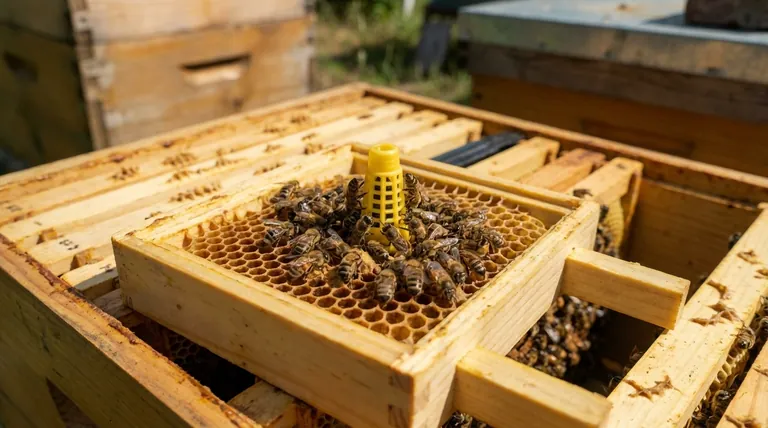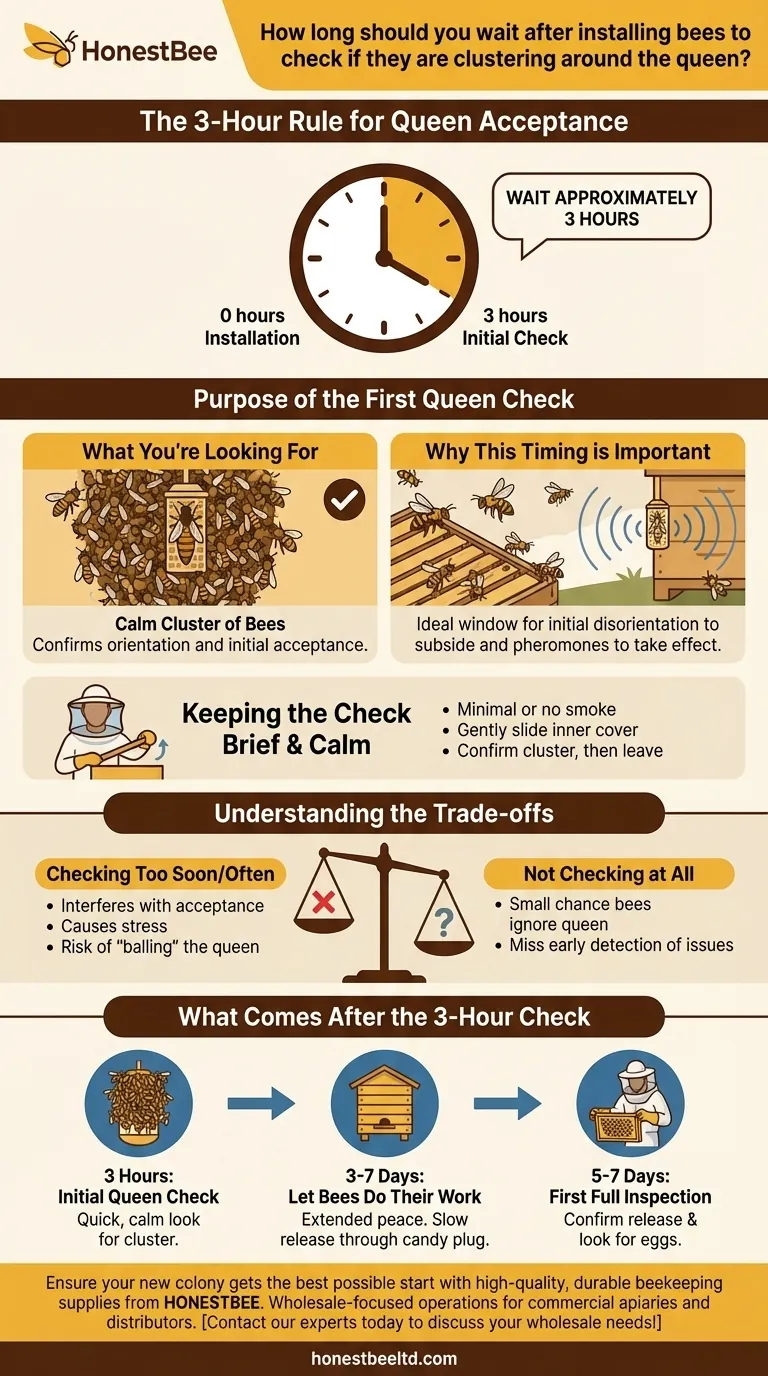After installing a new package of bees, you should wait approximately three hours before making your first check. This initial check is not a full inspection but a quick, minimally-invasive look to confirm the bees have found and are clustering around the queen cage.
The core principle is to balance the need for confirmation with the colony's need for stability. A brief check after a few hours confirms the bees are orienting to the queen, after which they must be left undisturbed for several days to complete the acceptance process.

The Purpose of the First Queen Check
This initial look-in is a critical data point that gives you peace of mind. It tells you that despite the chaos of installation, the colony is beginning to organize itself around its most vital member.
What You're Looking For: A Calm Cluster
You are looking for a calm cluster of bees covering the queen cage. This is a positive sign. These are attendant bees that have been drawn by her pheromones and are likely trying to feed and care for her through the mesh of the cage.
This behavior indicates the colony is accepting her as their new queen.
Why This Timing is Important
Three hours is the ideal window. It's enough time for the initial disorientation and stress of being installed to subside. The bees have had a chance to explore their new home and locate the powerful pheromones the queen is emitting.
Checking earlier might not yield useful information, as the bees may still be disorganized.
Keeping the Check Brief and Calm
This is not a full hive inspection. Your goal is to cause the least disturbance possible.
Gently and quietly remove the outer cover and slide the inner cover just enough to see the queen cage. Use minimal or no smoke. Once you see the cluster, replace the covers and walk away.
Understanding the Trade-offs of Intervention
Every time you open a hive, you disrupt the colony's environment and risk causing stress. Knowing when and why you are intervening is the hallmark of a good beekeeper.
The Risk of Checking Too Soon or Too Often
Disturbing the colony too early or too frequently can interfere with queen acceptance. Excessive disruption can stress the bees, who may perceive the queen as the source of the problem.
In a worst-case scenario, this stress can cause them to "ball" the queen—a defensive reaction where they surround and kill her by overheating her.
The Risk of Not Checking at All
While small, there is a chance the bees ignore the queen completely. This could happen if, for example, a virgin queen hatched during transit or the colony has decided to raise its own.
This quick 3-hour check allows you to spot this unlikely scenario early, providing crucial reassurance that the colony is on the right track.
What Comes After the 3-Hour Check
Once you have confirmed the bees are clustered on the queen cage, your job is to leave them alone.
Let the Bees Do Their Work
The colony now needs an extended period of peace, typically three to seven days. This gives them time to chew through the candy plug in the queen cage and release her on their own terms. This slow release is a crucial part of the acceptance process.
Your First Full Inspection
Your next inspection, about a week after installation, is when you will gently open the hive to confirm two things: that the queen has been released from her cage and, ideally, that she has begun laying eggs.
Making the Right Choice for a Healthy Colony
Your actions in the first week are critical for the long-term success of your new colony. Use these guidelines to inform your approach.
- If your primary focus is minimizing colony stress: Perform the 3-hour check as quickly and calmly as possible, then do not open the hive again for at least five to seven days.
- If your primary focus is early confirmation: Use the 3-hour check to verify the bees are clustered on the queen cage, which is the most reliable sign of initial acceptance.
Trust in the bees' natural process once you confirm they are starting to bond with their new queen.
Summary Table:
| Timing | Purpose | Key Action |
|---|---|---|
| ~3 Hours After Installation | Initial Queen Check | Quick, calm look for a cluster of bees on the queen cage. |
| 5-7 Days After Installation | First Full Inspection | Confirm queen release and look for the start of egg-laying. |
Ensure your new colony gets the best possible start with the right equipment from HONESTBEE. We supply commercial apiaries and beekeeping equipment distributors with high-quality, durable beekeeping supplies through our wholesale-focused operations. Let us help you build a thriving apiary. Contact our experts today to discuss your wholesale needs!
Visual Guide

Related Products
- Jenter Queen Rearing Kit Complete Set for Bee Breeding
- Nicot Queen Rearing Kit for Beekeeping and Grafting in Nicot System
- No Grafting Queen Rearing Kit: System for Royal Jelly Production and Queen Rearing
- Professional Galvanized Hive Strap with Secure Locking Buckle for Beekeeping
- Langstroth Honey Bee Box Hive Boxes for Different Depths
People Also Ask
- What is the timeline for queen breeding? A 28-Day Guide from Egg to Laying Queen
- How can beekeepers start a honey bee breeding program? Build a Superior, Resilient Apiary
- What is queen rearing in beekeeping? Take Control of Your Apiary's Genetics
- What are the implications of delayed oviposition in queen bees? A Strategy for Superior Queen Quality
- What genetic pathways differ in QE-queens? Unlocking the Master Controls of Queen Bee Biology



















